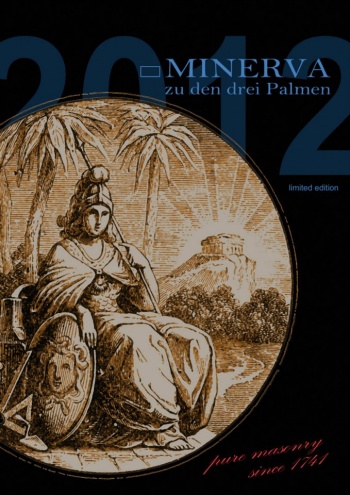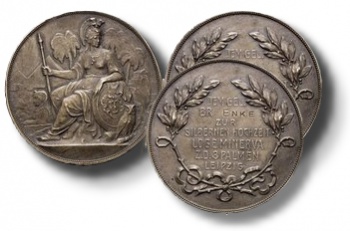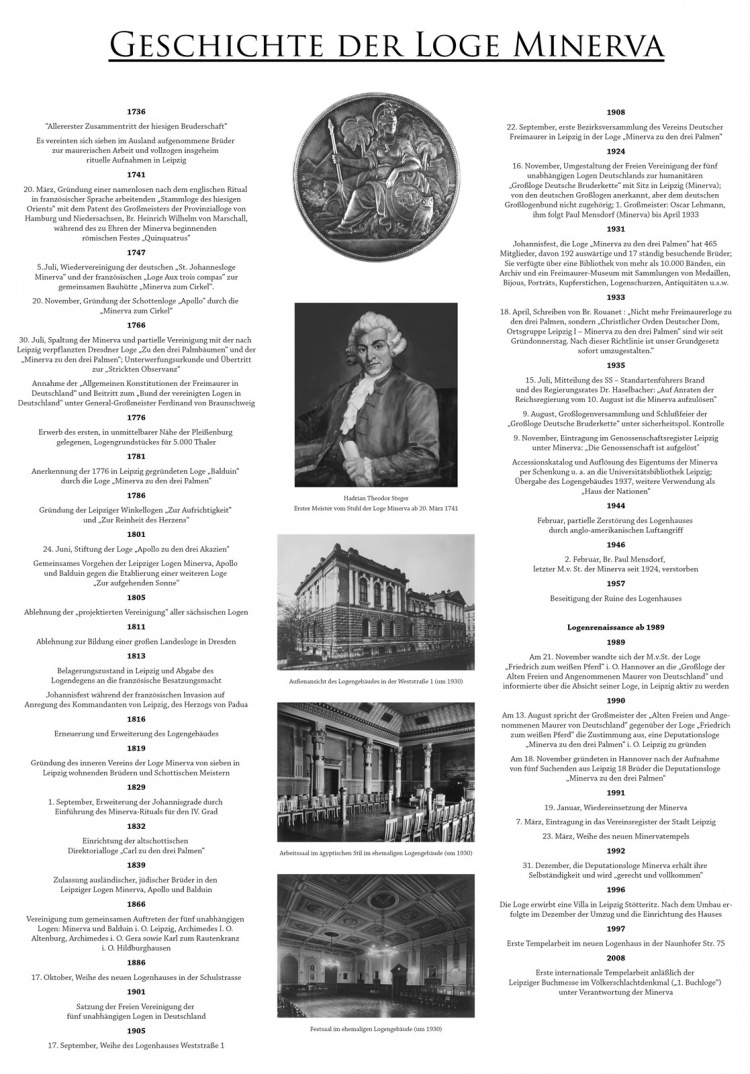Minerva zu den drei Palmen
| Johannisloge:
"Minerva zu den drei Palmen" | |
| Orient: | Leipzig |
| Matr.-Nr.: | 7 |
| Gründungsdatum: | 1741 |
| Großloge: | AFuAMvD |
Minerva zu den drei Palmen
Die Loge "Minerva zu den drei Palmen" Nr. 7 i. Or. Leipzig wurde als namenlose "Stammloge des hiesigen Orients" am 20. März 1741 gegründet, während des zu Ehren der Minerva beginnenden römischen Festes Quinquatrus.
Entwicklung der Loge
1745 beschließen die Brüder, ihrer Loge den Namen "St. Jean aux trois compas" („St. Johannes zu den dreyen Cirkuln“) zu geben.
25. August 1746: Gründung der deutschsprachigen Loge Minerva in Rücksicht auf die Universität Leipzig.
05. Juni 1747: Wiedervereinigung der beiden Logen "Minerva" und "Aux trois compas" zu der Loge "Minerva zum Cirkul" unter Billigung des Distriktsgroßmeisters von Obersachsen, Br. Friedrich August Graf von Rutowski.
Unter dem Schutze der Strikten Observanz
Quelle: Internationales Freimaurer-Lexikon von Eugen Lennhoff und Oskar Posner (1932)
Die Logen "Minerva zu den drei Palmen" und "Balduin zur Linde" in Leipzig. Die "Minerva" wurde 1766 unter dem Schutze der Strikten Observanz gegründet und sagte sich in den achtziger Jahren des 18. Jahrhunderts von diesem System los.
Sie blieben unabhängig, schloßen sich dem entstandenen Sächsischen Logenbund nicht an und bewahrten die Kennzeichen ihrer Entstehungsart bis zum Jahre 1884, als sie den Erkenntnisgrad ablegten und sich auf die drei Johannisgrade beschränkten. Die Loge "Balduin zur Linde" wurde 1776 von dem damaligen Großmeister der Großen Landesloge, Herzog Ernst von Sachsen-Gotha, eingeweiht und arbeitete bis 1807 unter dieser.
Am 7. November 1807 erklärte sie sich selbständig, ließ sich aber 1809 von der Provinzial-Großloge von Hamburg eine neue Stiftungsurkunde aussstellen. Von 1815 angefangen gehörte sie dem Sächsischen Logenbund an, trat 1824 aus und behielt ihre Selbständigkeit bis zum Eintritt in die Großloge "Deutsche Bruderkette" (1924). Die Regularität dieser Logen wurde im 19. Jahrhundert nie bestritten. Sie nannten sich selbst "isolierte Logen", hatten gemeinsame Interessen, die auch durch eine Zeitschrift, "Am Reißbrett", vertreten wurden und schlossen sich 1884 zu einer "Freien Vereininigung" zusammen, die von einem geschaftsführenden Ausschuß verwaltet wurde.
Bibliothek der Minerva
Es werden von der Loge über 1000 Bücher, Dokumente und Tonträger verwaltet.
Artikel über die Bibliothek im amerikanischen Freimaurer-Magazin "The Builder"
Erschienen 1930. Quelle: Phoenixmasonry
KATALOG DER BIBLIOTHEK DER LOGE MINERVA ZU DEN DREI PALMEN, LEIPZIG. BY Karl Markert. Part 1. Leipzig, Germany. RM2.75 ($0.70).
THE American Mason who does not have contact with the Craft in Great Britain and continental Europe by means of membership in various research lodges and associations, correspondence with overseas brethren, or as a reader of foreign periodicals, misses many of the delights which Freemasonry holds for its students. His views cannot help but be more or less provincial if his knowledge of Freemasonry is restricted to his own Jurisdiction, or his own country. It may come as a surprise to such a Mason to learn that the craft in foreign lands functions in ways different than his own, and that there is a past and present spirit to the Fraternity which can only be understood by a knowledge of its history and literature.
A brief introduction to the bibliography of Freemasonry appeared in The BUILDER for August, 1923, pages 250-51, in which the colossal Wolfstieg Bibliographie der freimauerischen Literatur was reviewed; another account of the same work, with the story of the Beyer and Quint supplements, was given in the Iowa Grand Lodge Bulletin, January, 1928, pages 435-37. Both are from the present reviewer's pen. Each review gives the essential facts regarding the principal foreign catalogues; we have nothing in the English language which approaches the Wolfstieg-Beyer-Quint productions in number of items, wealth of description and detailed classification.
The two best American lists are the Catalogue of the Masonic Library ... belonging to Samuel C. Lawrence [Boston, 1891], and the 1873 and 1884 catalogues of the Iowa Masonic Library, Cedar Rapids, Iowa. The Grand Lodge of Iowa in 1925 authorized a Parvin Memorial Catalogue of the Iowa Masonic Library, but no funds were appropriated until 1929 for this purpose - and then only an amount quite insufficient for the work in hand. Let it be said, however, that the plan is to make an appropriation yearly until the funds are sufficient to produce the catalogue; but unless more than the mere title and author of a book is given, the long awaited production will have no such worth as the European catalogues already published, or in progress.
It is devoutly to be wished that at least the great rareties which the Iowa Masonic Library possesses will be described in minute detail, such as can be done in most capable fashion by the skilled and experienced assistant librarian now working under the direction of Bro. C.C. Hunt, Grand Secretary and Librarian. My own activities in that great Library from 1925 to 1929 give me a most intimate knowledge of the treasures to be found there.
With this lengthy introduction - which I feel is justified because the present review covers only one out of twelve parts to be issued within the next two years or so - we can examine Part I in detail. The pages give promise of a good sized volume; they measure 11 x 7 1/2, and Part I has sixty-four pages. There is a frontispiece depicting an interior view of the lodge library, with books neatly arranged in closed eases. Subscribers to these parts (I state this for the benefit of the half-dozen leading American Masonic libraries which have subscribed for the catalogue upon my earnest recommendation ) may rest assured that there will be a title page and an introduction to the volume when all parts are completed.
Sixteen pages of the catalogue are devoted to manuscripts alone - and at the very outset the author states that only a portion of the collection is listed. Bro. Markert whets one's appetite in the very first sentence, in which he tells us that among the treasures are manuscripts from the period of the Rite of Strict Observance, as well as the diaries of Baron von Hund and material formerly owned by Bro. Johann Georg Eck. Von Hund needs no introduction to the students of Freemasonry and the older rites; Eck (1746-1808) was an associate of Von Hund and the sixteenth Master of the Lodge zu den drei Palmen, Leipzig. The diaries and the Eck material are to be published some time in the future. Libraries and students take note!
To Eck goes the credit for making the first catalogue of the Lodge; there is a manuscript with 476 titles listed, compiled in 1806. Others follow - circa 1810, 1839 and 1838-1900. Biographies, histories, manuscript songs and lyric poetry, occult and mystical papers - these are just a few of the subjects included in the manuscript collection.
Part B opens with encyclopedias and dictionaries. Those who fondly imagined that the Mackey Lexicon (1842) or his Encyclopedia (1874) were the first books of the kind will be surprised to know that Lenning wrote a three-volume work as early as 1822; its modern successor is the famous Allgemeines Handbuch der Freimaurerei [Leipzig, 1900-01]. I do not find Mackey listed, but Waite's two-volume encyclopedia appears, as does Bro. Merz's Ask Me, Brother! Tschoudy's L'etoile flamboyante 1766) is the oldest reference work listed; there are many reissues known to the student.
The second section of Part B treats of bibliographies. Here is where the bookworm can revel! Bro. Silas Shepherd's fine list of 1923 appears, but what treasures of the eighteenth century and the early nineteenth do we find included! One could write a whole article on them alone. A familiar item is the Barthelmess catalogue of Pythagoras Lodge No. 1, Brooklyn, N.Y., 10 and 146 pages, printed in 1859.
Periodicals are numerous. One observes that the Lodge lacks Vol. 32 of Ars Quatuor Coronatorum, and Vols. 4, 6, 7 and 9 of THE BUILDER. Does any reader of this review wish to donate these missing volumes to the German Library? Another treasure is a goodly run of The American Freemason, Storm Lake, edited by the redoubtable Joseph E. Morcombe. Ah, that was a fearless periodical – and one really representative of the best the American Craft has to offer. But its worth was recognized by too few, and it went the way of all non-commercial publications struggling without endowment.
Sometimes Masonic bibliophiles wonder where the good old treasures go. To begin with, here are two rareties from England - The Free Mason's Pocket Companion, (Smith's) editions of 1736 and 1738. The catalogue states that the 1736 is the "eldest Pocket-companion," but there was one earlier, published in 1735. There are German translations of the Pocket Companion of 1738 and 1740 at Leipzig.
American Masonic libraries which regard lodge notices, lists, etc., of no account can take a lesson from the Leipzig library, which has preserved, in 235 thick volumes, rosters of lodges on the exchange list, ranging from 1870 to 1930. What a fertile field for the researcher who seeks an answer to the question, was So-and-So a Freemason? If we had taken the precaution to preserve the printed lists, etc., of our early American lodges, we might be able to claim a few more notable Americans as members of the Fraternity.
Pages 40 to 64 contain titles of Grand Lodge publications, local lodge histories, serial works, chrestomathies, addresses, and books on general Masonic topics.
The compiler, Bro. Karl Markert, is to be congratulated upon his capable production. He has set a high standard for those who would bring out similar works. The part before me is ample assurance that the remaining issues of the catalogue will be sought after by libraries and collectors. The terms of subscription are RM 2.75 for each part, equivalent to about seventy cents. Orders can be placed with Markert and Petters, Publishers, Leipzig, C-1, Germany. Brethren desiring the catalogue must agree to purchase the entire work, which is planned to cover twelve parts. J.H.T.
Ehemalige Logenbibliothek
Bevor die Bibliothek zerstreut wurde, war sie die bestgeordnete und größte in Deutschland in Bezug auf Freimaurerei.
"Vor der Enteignung durch die Nationalsozialisten betrug der Umfang der Sammlung mehr als 10 000 Bücher. Einiges davon ist heute noch in aller Welt verstreut, Vieles davon wohl für immer verschollen. Wir sind immer auf der Suche nach alten Beständen der Loge und freuen uns über jeden Hinweis, der uns erreicht." Volker Helm, Bibliothekar der Loge MINERVA
Berühmte Logenbrüder
- Ernst Anschütz, Dichter von "Fuchs, du hast die Gans gestohlen"
- Anton Philipp Reclam, "Reclams Universalbibliothek"
- Arthur Schimmel, Pianofortefabrikant
- Wilhelm Müller, genannt "Griechenmüller"
- Gottfried Josef Gabriel Findel, Buchhändler, freimaurerischer Schriftsteller
- Samuel Hahnemann, Begründer der Homöopathie
- Siegfried August Mahlmann, Komponist, Liederdichter
Quellen
- Ausgearbeitete Unterlagen von K.-D. Holz aus dem Besitz des Artikelautoren Goldapfel
Zur besseren Lesbarkeit der nachstehenden Tafel bitte zweimal ins Bild klicken !
Minerva-Kalender 2012
Siehe auch
- Buchloge
- Traktat: Mensch und Krieg - Leipziger Buchloge 2013
- Traktat: Vom Selbstverständnis der Freimaurer
Links
- 270. Stiftungsfest 25.-27. März 2011 https://mzddp.de/index.php?option=com_content&view=article&id=107&Itemid=95
















